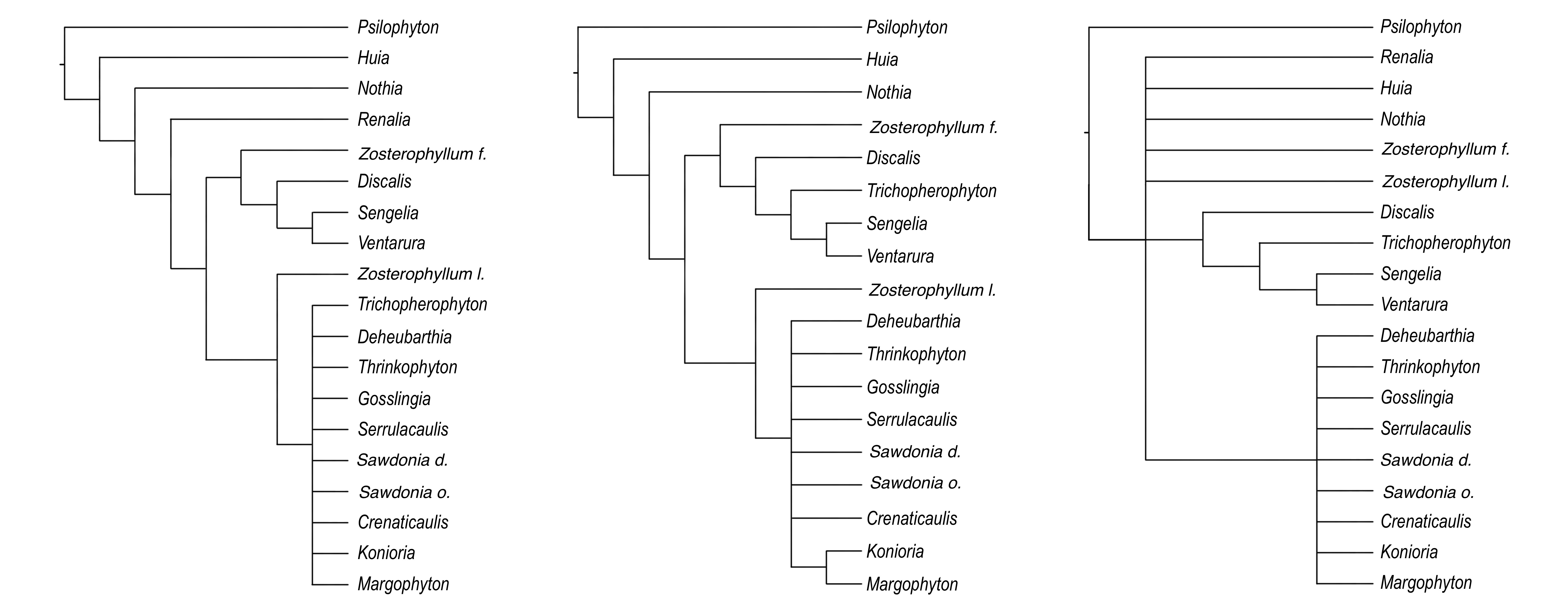Research
While my academic upbringing comes from the world of paleobotany, I am interested more broadly in how we can utilize modern tools to better understand plant evolution on a macroevolutionary scale, specifically relating to the plant form. My work focuses on extinct & extant seed-free vascular plant morphology, anatomy, and evolution.
The evolutionary history of isoetalean lycopsids
The rhizomorphic lycopod lineage (Isoetales herein) has a history that extends over 400 million years into the Devonian and persists still today. During the Carboniferous, arborescent lycopods dominated the Earth’s landscape and left an abundant fossil record, placing the Carboniferous Isoetales among the best characterized groups of fossil plants. However, climatic and geologic changes triggered a shift in the ecological role of Isoetales, diminished their diversity in terrestrial ecosystems, and created conditions unfavorable to plant fossilization (e.g., Permian- Triassic coal gap). Together, these events obscure key data on the last 320-million-years of their evolutionary history, including pivotal evidence on the origins of modern Isoetes. Only a small fraction of isoetalean macrofossils are known from the Triassic, and an even smaller portion of these are anatomically preserved. Similarly, a few isoetalean macrofossils are known from Antarctica but none are Triassic permineralizations. Here we report a new lycopod fossil from the Triassic Fremouw Formation of Antarctica. This specimen is permineralized in a silicified peat and was studied using the cellulose acetate peel technique. The fragment is partially compressed and incompletely preserved. Anatomical details of this specimen can only be observed when peels are attached to the slab surface, making many details of their morphology and anatomy challenging to reconstruct. Nevertheless, the anatomy that is preserved indicates the specimen has an isoetalean affinity. The primary vascular tissues are not preserved but the secondary xylem cylinder is present, measuring approximately 15-20 cells (3.2 mm) thick. To the outside of the secondary xylem is a multilayered cortex composed of homogenous, parenchymatous cells. These layers create a rippling pattern, although it is unclear whether this is a taphonomic artifact or true to the specimen, and regularly arranged isoetalean rootlet traces are found on one side of this axis. Owing to the rarity of permineralized Triassic isoetaleans, this specimen provides crucial data on the anatomy and diversity of Mesozoic Isoetales and will advance our understanding of the evolutionary history of rhizomorphic lycopods.
Cyathealean ferns
The Cyatheales, colloquially known as tree ferns, are found today in tropical to temperate regions worldwide. Modern molecular classification of the order includes eight families containing 13 genera and 713 species. Cyathealean ferns may date back as early as the Triassic, and become prominent components of floras later in the Mesozoic. Despite their plentifulness in the fossil record, identifying these fossils poses many challenges. Molecular classifications of this order based on extant members, in many cases, lack strong morphological synapomorphies. In addition, the morphology of single organs of the Cyatheales can often resemble those of distantly related ferns. These difficulties, coupled with inconsistent classification and frequent movement of fossil and living ferns on several taxonomic levels, has resulted in an inordinately complicated taxonomic history of the Cyatheales. In addition to describing a new fossil fern specimen, I hope this work can highlight the importance of considering morphological data in the phylogenetic analysis of ferns, stress the importance of standards in qualitative morphological description, and illustrate the value in classical morphological and anatomical study of plants. You can access the abstract for the talk I gave on some new fossil cyathealean ferns here.
Zosterophyll systematics

Devonian floras illustrate the earliest radiations of vascular plant diversity, and allow paleobotanists a unique appreciation for how these morphologically simple plants laid the groundwork for the immense variation in plant form since. One group of these plants, the zosterophylls, are the earliest members of the lycophytes. Members of this clade dominated Carboniferous landscapes, and persist today. Despite their pivotal systematic position relative to both the lycophytes and euphyllophytes, relationships within the group as well as with other Devonian plants remain murky. For the completion of my master's thesis, I built a matrix of taxa with a focus on anatomical characters, aiming to evaluate relationships within the group. The results of this project emphasized the importance of how utilizing both anatomical and morphological characters, especially with morphologically 'simple' plants, to render the most accurate representation of their relationships.
My work on zosterophyll systematics has been published in the International Journal of Plant Sciences special issue in honor of Francis Heuber.PDF Matrix Supplementals
Further directions for this research are (1) to more thoroughly investigate zosterophyll relationships with other groups of early vascular plants and (2) utilize this robust matrix as a portion of a much larger morphology- and anatomy-based phylogenetic analysis of lycophytes.
